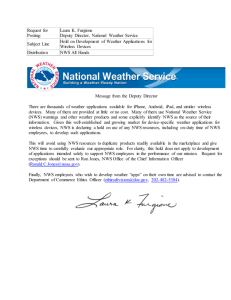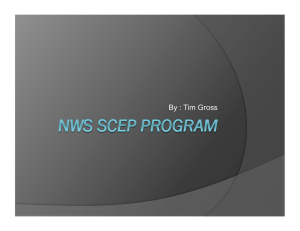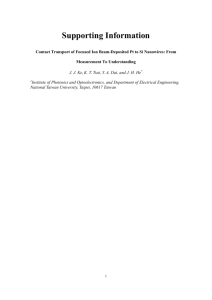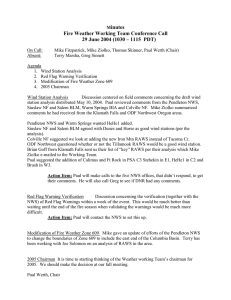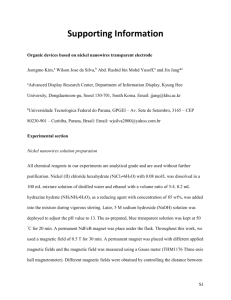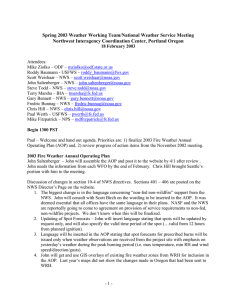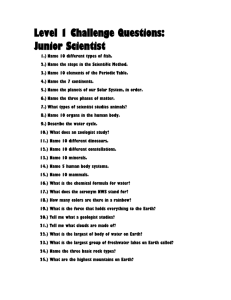Memorandum of Understanding
advertisement
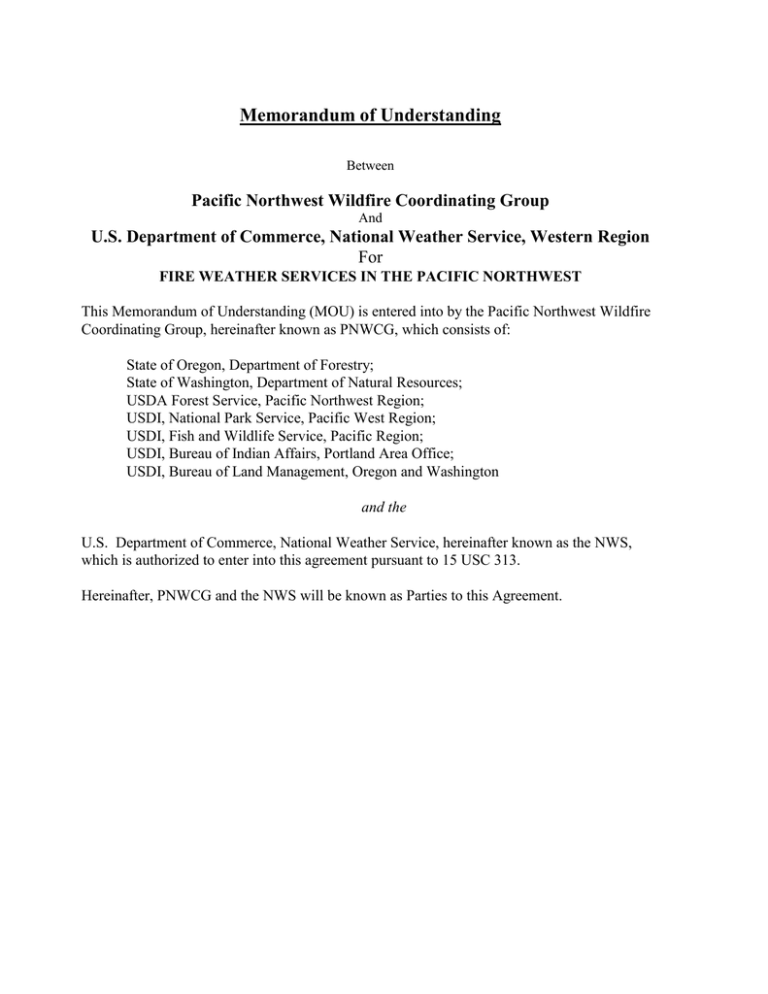
Memorandum of Understanding Between Pacific Northwest Wildfire Coordinating Group And U.S. Department of Commerce, National Weather Service, Western Region For FIRE WEATHER SERVICES IN THE PACIFIC NORTHWEST This Memorandum of Understanding (MOU) is entered into by the Pacific Northwest Wildfire Coordinating Group, hereinafter known as PNWCG, which consists of: State of Oregon, Department of Forestry; State of Washington, Department of Natural Resources; USDA Forest Service, Pacific Northwest Region; USDI, National Park Service, Pacific West Region; USDI, Fish and Wildlife Service, Pacific Region; USDI, Bureau of Indian Affairs, Portland Area Office; USDI, Bureau of Land Management, Oregon and Washington and the U.S. Department of Commerce, National Weather Service, hereinafter known as the NWS, which is authorized to enter into this agreement pursuant to 15 USC 313. Hereinafter, PNWCG and the NWS will be known as Parties to this Agreement. I. PURPOSE The purpose of this MOU is to implement the findings and recommendations of the Modernization and Transition Committee (MTC), dated September 29, 1999 and December 8, 1999. The findings and recommendations are shown in Exhibit A and provide the foundation upon which this agreement is based. The September 29 consultation outlines the type of fire weather support that should be provided, i.e., additional forecaster positions beyond end state staffing levels for fire weather support and advocating permanent and dedicated fire weather forecasters. The December 8 MTC consultation provides recommendations regarding the qualifications of forecasters and describes the circumstances in which they are expected to provide fire weather services while staffing fire weather shifts, (recommends fire weather as the primary shift responsibility and that the shifts be staffed by fire weather qualified forecasters, although forecasters may perform other duties as long as such duties do not compromise fire weather responsibilities). This MOU provides a framework for cooperation and commitment by the PNWCG and the NWS to improve fire weather services and to document standards for forecasts and services. II. MUTUAL INTERESTS AND BENEFITS Federal agencies and the NWS have entered into a national Interagency Agreement for Fire Weather to cooperate in systems of fire weather and fire behavior predictive services essential to the success of fire management actions. The NWS has staffing available at its Weather Forecast Offices to provide fire weather services per the MTC certification documents shown in Exhibit A. PNWCG maintains fire management organizations in need of fire weather services. Fire weather services are a critical building block to fire management agencies in decisionmaking because human lives and valuable natural resources are at risk. It is the mission of the NWS to provide fire weather services and products to fire managers. It is the mission of the fire management agencies to analyze and interpret fire weather forecasts into fire behavior predictions when making decisions essential to the success of fire management actions. It is to the mutual advantage of PNWCG and NWS and in the public interest and for firefighter safety to coordinate efforts for weather services for fire management activities in the Pacific Northwest to minimize duplication of efforts and improve efficiency and effectiveness. Words and phrases used herein may have different meanings for different readers. To establish a common understanding, words and phrases as used in this document are defined in the Glossary of Terms, Exhibit B. III. THE NWS SHALL: Make best efforts to meet the PNWCG required Forecast and Service Standards as shown in Exhibit C recognizing the data sets from which the standards were established and the goal to continually improve forecasts. The season review described in Section V of this agreement will be used to evaluate progress towards meeting these PNWCG standards and any NWS program improvements that are needed to enable the NWS to achieve these standards will be implemented prior to the following fire season. Provide PNWCG with fire weather services by forecasters who meet the Fire Weather Forecaster Proficiency and Currency Standards, cooperatively developed by PNWCG and NWS, listed in Exhibit D. Provide a qualified fire weather forecaster at the Northwest Interagency Coordination Center for 40 hours per week during fire season (approximately March 1 through October 31) in accordance with applicable legal and administrative requirements. Specific dates and the names of forecasters who are assigned to the NWCC for that purpose will be provided by the Portland NWS WFO MIC after consultation with the NWCC annually by February 1. The application of Proficiency and Currency Standards listed in Exhibit D shall apply. Maintain staffing and services for the fire weather program, pursuant to the MTC findings and recommendations in Exhibit A, until the NWS has the advanced operational technology in place and demonstrates its ability to provide fire weather services equal to those prior to the implementation of Modernization and Restructuring (MAR). Emergencies which may take priority over some or all of the fire forecaster’s fire weather related duties thereby requiring the immediate assistance of the fire weather forecaster, are described as "Category One Priority" products in the NWS Western Region ROML "Prioritizing Products and Associated Activities for Western Region WFOs," as shown in Exhibit E. Non-emergency, non-fire weather related duties described as "Category Two Priority” and “Category Three Priority” products in the NWS Western Region ROML "Prioritizing Products and Associated Activities for Western Region WFOs," may be performed by forecasters on a dedicated fire shift only if such duties do not compromise their fire weather responsibilities. Any changes to this ROML that affect fire weather services shall not be made without consultation of the PNWCG. Seek the advice and counsel of the fire agencies prior to developing proposed alterations in the fire weather program and services provided in Oregon and Washington. NWS-developed proposals shall be provided to PNWCG for review, assessment, and comment prior to adoption and implementation. NWS shall consider any concerns expressed by PNWCG, especially as related to performance integrity, in its assessment of change proposals in the fire weather program and other services provided. 3 IV. PNWCG SHALL: Provide coordination and recommendations for interagency fire weather activities in Oregon and Washington through the PNWCG Weather Working Team. By authority of the PNWCG, the Weather Working Team is assigned the responsibility to administer and implement the provisions of this agreement. Review the baseline and standards shown in Exhibit C for applicability after the first year of this agreement and as needed thereafter. Provide weather observations seven days a week during fire season and coordinate and cooperate with the NWS in fire weather forecasting. The agencies will seek the advice and counsel of the NWS regarding observational issues (e.g. moving remote automatic weather stations). Provide work space and office equipment to the dedicated NWS fire weather forecaster stationed at the Northwest Coordination Center. In addition, in accordance with applicable legal and administrative requirements, PNWCG may provide other opportunities to NWS employees for assignments to the Northwest Coordination Center or state offices during the fire season to the extent desired by the NWS. These opportunities will be coordinated between the NWS offices and the receiving office. Recognize that other severe weather emergencies may require the services of the fire weather forecaster to assist in WFO operations. V. BOTH PARTIES SHALL: Work cooperatively as equal partners in the development, application and implementation of fire weather services to assure full compliance with mutually established performance, reliability, priority, and time standards. Recognize that lands for which the States are responsible for wildland fire protection in Oregon and Washington, and the lands for which the respective Federal Agencies are responsible, are intermingled or adjacent in some areas, and wildland fires on these intermingled or adjacent lands may present a threat to the lands of the other. Prepare an Annual Operating Plan (AOP) that includes each WFO with fire weather areas of responsibility in Oregon and Washington as required in the National Fire Weather Agreement. Development and maintenance of the AOP is a shared responsibility between the local land management program managers and the MIC of the servicing WFOs. At a minimum, the AOP will include the items listed in Appendix I of the National Agreement which is shown in Exhibit F. Additional requirements noted in this agreement or resulting from annual reviews will apply to all WFOs that serve Washington and Oregon. The AOP provides the outline and details of fire weather products and services for local areas. As such, the annual operating plan can amplify but will not fundamentally modify the basic 4 responsibilities of this agreement. The AOP will be developed annually no later than March 1. The AOP shall include a signatory page on which a representative from PNWCG and the NWS will sign. Map and describe NWS fire weather forecast zones and boundaries by March 1, 2002 that will be assigned to WFOs. Zones may be periodically reviewed in the future. The zones will be included in the AOP. Review the progress of the NWS in meeting baseline standards and progress towards meeting the NWS Director's visions and goals statement that projects a 30% or greater increase in accuracy by 2005. Each WFO's program will be evaluated on a seasonal basis using the parameters described in Exhibits C and D. The parties will evaluate and compare individual fire season statistics to PNWCG requirements and end-of-season customer evaluations to determine what program adjustments are needed and appropriate. Conduct the review stated above and evaluate fire weather services for Oregon and Washington and recommend improvements. The PNWCG Weather Working Team and the NWS MICs from Boise, Medford, Pendleton, Portland, Seattle and Spokane shall conduct the review. The PNWCG and the NWS shall meet bi-annually in February and November. The February meeting will decide on changes in fire weather services for the upcoming fire weather season, which will be reflected in AOP. The November meeting will evaluate the past season fire weather services from WFOs and recommend changes for the next fire season. The evaluation and recommendations shall be contained in a written report to the PNWCG Chairperson and Western Region Regional Director and be delivered no later than December 15. Respond to the other party's proposals within thirty (30) days, or advise the other party when the proposal will be addressed if the NWS or the Weather Working Team are unable to meet or discuss the proposal within their respective groups in that time frame. Except when necessary to meet emergency needs, significant proposals are expected to be discussed at the biannual meetings Recognize the primary role of the States in administering smoke management plans in their respective states. Allow, as permitted by law, one another the use of communications systems such as radio frequencies, computer system access, data transmission lines, and communication sites when there is a mutual benefit to both Parties. Cooperate and coordinate plans for the weather-related training of fire personnel and fire weather forecasters to ensure that training needs are met. 5 VI. GENERAL PROVISIONS PRINCIPAL CONTACTS. The NWS contact for agreement administration issues will be Meteorological Service Division Chief. The PNWCG Weather Working Team chairman will be the contact for the fire agencies. The names, addresses and phone numbers of the respective individuals will be provided to the partner entity by February 1 of each year. In relation to the NWS position serving at the NWCC, the contacts will be the NWCC Fire Weather Program Manager and the MIC at NWS Portland. BI-ANNUAL REVIEWS. The parties will meet in February and November each year to review matters of mutual concern and review the AOP described in Section V, above. MODIFICATION. This agreement is a consolidated document applicable to all WFOs that provide service to PNWCG. NWS regional or WFO proposed amendments to this document will be submitted to the PNWCG through Western Region Headquarters for review and approval by PNWCG. PNWCG proposed amendments to this document will be submitted to the NWS Western Region for review and approval prior to effect or implementation. No amendments will be implemented or effective until approved and signed by (1) the Director, NWS Western Region and (2) the Chairman, PNWCG Steering Committee. FREEDOM OF INFORMATION ACT (FOIA). Any information furnished under this instrument is subject to the Freedom of Information Act (5 U.S.C. 552). TERMINATION. Either Party, in writing, may terminate this instrument in whole, or in part, before the date of expiration, by providing sixty (60) days advance written notice. Neither Party may terminate this Agreement between March 1 and November 1 of any year. PARTICIPATION IN SIMILAR ACTIVITIES. This instrument in no way restricts the PNWCG or the NWS from participating in similar activities with other public or private agencies, organizations, and individuals. COMPLETION DATE. This instrument is executed as of the date of last signature and, unless sooner terminated, is effective for five years after the date of the last signature, at which time it will expire unless renewed. NON-FUND OBLIGATING DOCUMENT. This instrument is neither a fiscal nor a funds obligation document. Any endeavor or transfer of anything of value involving reimbursement or contribution of funds between the parties to this instrument will be handled in accordance with applicable laws, regulations, and procedures including those for Government procurement and printing. Such endeavors will be outlined in separate agreements that shall be made in writing by representatives of the parties and shall be independently authorized by appropriate statutory authority. This instrument does not provide such authority. Specifically, this instrument does 6 not establish authority for noncompetitive award to the cooperator of any contract or other agreement. Any contract or agreement for training or other services must fully comply with all applicable requirements for competition. In addition, all parties' participation in this MOU is subject to the availability of appropriated funds. RESOLUTION OF DISAGREEMENTS. Both parties will work together to resolve problems in “near-real time.” Concerns from either party will be brought to the attention of the appropriate management level as soon as possible for resolution. Problems will be brought forward in a timely manner. Should disagreement arise on the interpretation of the provisions of this agreement, or amendments and/or revisions thereto, that cannot be resolved at a particular working level, the area(s) of disagreement shall be stated in writing by each party and presented to the other party for consideration. If agreement on interpretation is not reached, the parties shall forward the written presentation of the disagreement to respective higher officials for appropriate resolution. 7 FIRE WEATHER SERVICES IN THE PACIFIC NORTHWEST Signature Page _/s/Mark Forbes_______ Chairman, PNWCG _/s/Vickie L. Nadolski_ Director, National Weather Service, Western Region _3/28/01______________ Date _3/20/01 ____________ Date 8 FIRE WEATHER SERVICES IN THE PACIFIC NORTHWEST EXHIBIT A Modernization and Transition Committee Findings MODERNIZATION TRANSITION COMMITTEE Completion of Final Consultation of Certifications for: WSO Olympia (FW), WA Closure WSO Wenatchee (FW), WA Closure The Modernization Transition Committee (MTC) has reviewed the certifications listed above. One public comment, relating to both offices was received during the 60-day public comment period in response to the notice published in the Federal Register. The concerns expressed by the Pacific Northwest Wildfire Coordination Group (composed of local/state/federal agencies) have been addressed by the National Weather Service (NWS). The MTC recommends these certifications be approved with the following understanding. The MTC endorsement to close these weather offices does not relieve the NWS of their responsibility to retain transitional staffing for the Fire Weather program. As outlined in the "Report of the Fire Weather Team," June 11, 1998, the transitional staffing must be retained until NWS has the advanced operational technology in place and demonstrates its support to the satisfaction of the fire weather customers. [s] Peter R. Leavitt 9/29/99 Peter R. Leavitt Chair, Modernization Transition Committee Date 9 FIRE WEATHER SERVICES IN THE PACIFIC NORTHWEST EXHIBIT A (continued) Modernization and Transition Committee Findings MODERNIZATION TRANSITION COMMITTEE Consultation of Certifications for: WSO Redding, CA WSO Riverside (FW), CA WSO Salem (FW), OR Consolidation/Automation/Closure Closure Closure The Modernization Transition Committee (MTC) has reviewed issues associated with closing offices having fire weather forecasting responsibilities. We consider fire weather forecasting a unique responsibility because lives are placed at risk. Many long-term concerns about fire weather forecasting remain and cannot be resolved in time to allow the MTC to act on some of the closings. During the review, we learned that 37 additional interim FTEs have been authorized to support the fire weather forecasting mission nationwide during the transition. The MTC does not believe the use of core forecasters will provide adequate support for the fire weather mission. The MTC advocates permanent and dedicated fire weather forecasters to ensure adequate support for fire weather activities. These dedicated forecasters would be in addition to the end state staffing level. The MTC requests copies of fire weather forecasters' position description and core meteorologists' position description having fire weather responsibilities. In addition, the NWS must honor the Interagency Agreement with the California Wildfire Coordination Group and not transfer personnel or fire weather responsibilities from the Redding and Riverside Geographical Area Coordination Centers (GACC) until a mutually acceptable transfer plan has been developed and implemented. The MTC also requested a plan for the Pacific Northwest fire weather transition. [s] Peter R. Leavitt 9/29/99 Peter R. Leavitt Chair, Modernization Transition Committee Date 10 FIRE WEATHER SERVICES IN THE PACIFIC NORTHWEST EXHIBIT A (continued) Modernization and Transition Committee Findings MODERNIZATION TRANSITION COMMITTEE COMPLETION OF Final Consultation of Certifications for: WSO Salem (FW), OR Closure The Modernization Transition Committee (MTC0 has reviewed the closure certification listed above. One public comment was received during the comment period in response to the notices published in the Federal Register. The MTC also reviewed a letter from the Pacific Northwest Wildfire Coordinating Group (PNWCG) dated December 6, 1999. The concerns expressed are being addressed and an agreement between the National Weather Service (NWS) and the PNWCG is to be developed. The MTC recommends closure of the Salem WSO contingent upon the NWS and the PNWCG reaching agreement on how fire weather services will be provided in the States of Washington and Oregon. The MTC recommends that NWS offices in the Pacific Northwest staff a shift whose primary responsibilities are the provision of fire weather forecasts and services, and that these shifts be staffed by fire weather qualified forecasters, as determined by the application of proficiency and currency standards. The Meteorologist In Charge may assign other duties in a manner, which will not compromise the integrity of the fire weather services. [s] Peter R. Leavitt Dec. 8, 1999 Peter R. Leavitt Chair, Modernization Transition Committee Date 11 FIRE WEATHER SERVICES IN THE PACIFIC NORTHWEST EXHIBIT B Glossary of Terms Annual Operating Plan (AOP): A plan developed and maintained as a shared responsibility between the local fire management program managers, the PNWCG Weather Working Team and the MIC of the servicing WFO. Competency: A combination of knowledge, skills, and abilities which; when acquired, allows a person to perform a task or function at a specifically defined level of proficiency. “Interagency Fire Program Management Qualifications Guide.” Currency: The amount of time interval, or frequency spent performing a task or function to maintain proficiency. Customer: A user of fire weather services and products. Dedicated fire weather staffing: A staffing configuration which utilizes a “Dedicated Fire Weather Forecaster” who is devoted to providing the needed fire weather products and services. The MIC may assign other duties in a manner which will not compromise the integrity of the fire weather services per Western Region ROML W-8-00 and sections of this agreement. Interagency: Involvement of two or more agencies party to this Agreement. Northwest Interagency Coordination Center (NWCC): The fire coordination center operated by PNWCG agencies, located in Portland. Proficiency: Well advanced in the science of meteorology and fire weather with competency in the production and delivery of fire weather products and services that have been proven and accepted. Unit Administrator: Individual assigned administrative responsibility for an established organizational unit, e.g.: Forest Supervisor for the Forest Service District Manager for the Bureau of Land Management Agency Superintendent for the Bureau of Indian Affairs Park Superintendent for the National Park Service Refuge Manager (Project Leader) for Fish and Wildlife Service Region Manager for State of Washington Department of Natural Resources District Forester for State of Oregon Department of Forestry Meteorologist in Charge for the National Weather Service. 12 FIRE WEATHER SERVICES IN THE PACIFIC NORTHWEST EXHIBIT C Forecast and Service Standards A. NFDRS Forecast Proficiency Standards The following standards are based on the minimum expected improvement over persistence forecast on an annual basis for zone averages or key stations within a fire weather zone based upon John Werth’s forecast verification program as modified by Tom Eggers (Boise WFO) for AWIPS (FWXVER, Version 1.0): Parameter **Annual Minimum Baseline Improvement over persistence forecast Temperature: Relative Humidity: Wind speed: Fuel moisture: 35% 25% 10% 15% **(VISION 2005 National Weather Service Strategic Plan for Weather, Water, and Climate Services 2000 - 2005 specifies a goal of 30% improvement by 2005, which is in addition to the improvements noted above) B. Narrative Forecast Accuracy and Resolution Requirements STATE OF WEATHER: A number on a scale of 0-9, which describes the weather. Accuracy required is +/- one code figure for codes 0-8. Accuracy required for code 9 is correctly forecasting it 85% of the time. AIR TEMPERATURE: Accuracy required is +/- 5 degrees (F), 90% of the time. RELATIVE HUMIDITY: Accuracy required varies based on the RH as follows, but all must be met 90% of the time. RH <30% RH 30-50% RH > 50% +/-4% +/-7% +/-10% WIND SPEED AND DIRECTION: Wind is measured at 20 feet above ground or 20 feet above the average height of the vegetative cover. Accuracy required is +/- 5 mph and +/- 30 degrees direction, 90% of the time. WETTING RAIN: A "yes" or "no" field, correct 80% of the time. LIGHTNING: To be established. TRANSPORT WINDS: (Washington only) The mean wind speed and direction within an 13 atmospheric layer bounded by the surface and such elevations which are determined to be significant for local user agency smoke management purposes. Accuracy required is +/- 5 mph and +/- 30 degrees direction, 90% of the time. MIXING DEPTH: (Washington only) The maximum depth as calculated above the terrain surface. Accuracy required is +/- 500 feet, 90% of the time. C. Spot Forecasts for Wildfires Spot forecasts for wildfires will be received as soon as possible, but at least within forty-five (45) minutes of request time. Parameter accuracy will be at least as good as that required in narrative forecasts. These additional requirements will also be met. INVERSIONS: Height above ground level of the bottom and top of inversions. Accuracy required is +/-500 feet with the time of the inversion dissipation/breakdown +/- one hour and accurate 80% of the time. This standard applies to spot forecasts (when information is requested) and wildfires. FREEZING LEVEL OF THE FREE AIR: Height above ground level of the 32-degree (F) isotherm during the forecast period. Accuracy required is +/-500 feet 90% of the time. This standard applies to spot forecasts (when information is requested) and wildfires. D. Special Forecasts for Prescribed Fires and other activities Spot forecasts for prescribed fires and forecasts for other projects will be received within sixty (60) minutes of the time of request unless the requesting individual agrees to the receipt of the forecast at a later time. E. Red Flag Warning and Fire Weather Watch There will be a working knowledge of locally developed red flag criteria. The average lead-time on red flag warnings will be at least six (6) hours for wind and relative humidity related warnings and two (2) hours for dry lightning events. Lead-time requirements may change as a result of agreements reached at the February and November semi-annual meetings. Fire weather watches will be issued 12 to 72 hours in advance of an expected event. Fire weather watches may be issued in the 0-12 hour time frame for dry lightning. The number of warnings will not exceed the number of watches. At least 60% of all red flag warnings will be preceded by a fire weather watch. 14 Verification standards will be based on Probability of Detection (POD), False Alarm Ratio (FAR) and Critical Success Index (CSI) values. POD, FAR and CSI for red flag warnings and fire weather watches will be determined with the statistical significance of the numbers being considered. Calculations of the statistics are described below. 1. Specific verification methods will be jointly developed no later than the November, 2001 semi-annual meeting and agreed upon by the NWS and PNWCG at the February, 2002 meeting. Methods include, but are not limited to, the stations to use in verification and the use of lightning detection systems that will be incorporated in the verification. 2. Specific verification criteria will be jointly developed no later than the November, 2001 semi-annual meeting and agreed upon by the NWS and PNWCG at the February, 2002 meeting. Criteria include the actual values of POD, FAR and CSI for each WFO and will be included in the Annual Operating Plan. Separate threshold criteria will be developed for warnings and watches for: 1) wind and relative humidity, and 2) dry lightning. Different criteria may exist for each WFO forecast area as agreed upon with PNWCG and local areas. Statistical Calculations Red Flag Event Yes No Forecast A C Not Forecast B N/A POD= A/(A+B). This is the fraction of the actual events correctly forecast. The more often an event is correctly forecast, the better the score. The best score is 1.0. The worst score is 0. FAR= C/(A+C). This is the fraction of all forecasts that were incorrect. The more often an event is forecast and does not occur, the worse the score. The best score is 0. The worst score is 1.0. CSI= A/(A+B+C). This is the ratio of correct forecasts to the number of events plus the number of incorrect forecasts. The best score is 1.0. The worst score is 0. F. Briefings and Consultation Briefings and consultation shall be short, concise presentations that highlight the fire weather problems of the day and the extended period. Internet briefings: The briefings will be timely and the forecaster trained in the technology used to present the forecast. The briefings will be well prepared, recognizing the critical fire weather patterns. 15 G. Training Weather training requested of the NWS by the fire community will be provided to the fire community in support of fire danger and fire behavior training. All requests for training in the Pacific Northwest will be met when at least three weeks notice has been given to the NWS. Training requests received by the NWS with less than three weeks notice shall be met to the maximum extent possible. All training applicable to a specific administrative area will be provided by a fire weather forecaster whose office forecasts for that administrative area to the maximum extent possible. H. IMET Dispatches and ATMU support All IMET and ATMU dispatch requests are met. The IMET will be en route within twelve (12) hours of request time. If IMET travel arrangements have not been finalized within 12 hours by the requesting agency, the IMET will be enroute as soon as travel arrangements have been finalized. 16 FIRE WEATHER SERVICES IN THE PACIFIC NORTHWEST EXHIBIT D Fire Weather Forecaster Proficiency and Currency A. Proficiency 1. Completion of fire weather forecaster training requirements (defined in ROML W-20-99). In addition, items 7,8 and 9 under the Meteorologist Baseline column in appendix B will be required for this agreement. 2. Work no less than five (5) shifts with a qualified fire weather forecaster, handling all duties of that shift including (but no limited to) the preparation and issuance of: -routine fire weather forecasts (pre-suppression). -spot forecasts -briefings -non-routine forecasts As many training shifts as possible should be worked during the critical fire weather season 3. WFO Fire Weather Program Leader and appropriate WFO Meteorologist-in-Charge concur and sign off on proficiency. B. Currency 1. The forecaster has prepared and issued 15 fire weather forecasts in past twelve months 2. The forecaster has prepared and issued 10 percent of office spots or five (5) spots in the past twelve months or has completed an IMET assignment. C. Proficiency Renewal Purpose: To renew fire weather proficiency of a forecaster if they have not met currency standards in element B. 1. Forecaster works no less than three (3) shifts with a qualified fire weather forecaster or successfully complete drill(s), which includes key aspects of local fire weather program. 2. WFO Fire Weather Program Leader and WFO Meteorologist-in-Charge concur and sign off on proficiency. 17 FIRE WEATHER SERVICES IN THE PACIFIC NORTHWEST EXHIBIT E NWS Western Region ROML W-8-00 Date March 20, 2000 W/WR1 A-10 Prioritizing Products and Associated Activities for Western Region WFOs This ROML replaces WR ROML WR-13-97 and is filed with WSOM Chapter A-10, Station Management PURPOSE: This Regional Operation Manual Letter (ROML) provides guidance for prioritizing products and activities associated with the preparation and dissemination of those products at National Weather Service (NWS) Weather Forecast Offices (WFOs). For the purposes of this ROML Nexrad Weather Service Forecast Offices (NWSFOs) and Nexrad Weather Service Offices (NWSOs) will be referred to as WFOs. This ROML applies to both normal operations and during back-up. Forecasters must use sound professional judgment in prioritizing warnings, watches, statements, and forecasts as they impact the NWS mission of protecting life and property. Since written instructions cannot address every situation, operational personnel must exercise initiative and professional judgment to minimize the risk to public safety. Protection of life and property takes precedence in all situations. INSTRUCTIONS: To assist WFOs in prioritizing office duties including public, river, aviation, marine, and fire weather, the following is guidance for warnings, watches, and other products that have priority. WFOs may expand upon this guidance to incorporate guidelines which meet unique local requirements, as appropriate. WFO management officials and shift leaders shall remain mindful of the need to proactively augment WFO staffing during major weather events/severe weather/fire outbreaks in their County Warning and Forecast Area. Products and associated support activities have been subdivided into three categories. Time sensitivity was taken into consideration as to the products ranking. Individual circumstances may change the ranking or category of products. CATEGORY ONE PRIORITY: These products are considered critical to saving lives and property. They should be prepared and disseminated as quickly and accurately as possible. Overtime is authorized for their preparation and dissemination. CATEGORY TWO PRIORITY: These products should not be delayed for more than one hour. Overtime is authorized to avoid excessive delays in their preparation and dissemination. CATEGORY THREE PRIORITY: These are products that can be delayed until all higher priority products have been issued. When these products cannot be issued in a timely manner, the product header should be transmitted with the message that the PRODUCT IS DELAYED - ESTIMATED TIME OF NEXT ISSUANCE IS xx A.M./P.M. Overtime is not authorized. Prioritization of services and activities associated with the preparation and dissemination of a product are ranked the same as the product. For example, collecting or making calls to spotters associated with a severe thunderstorm, the dissemination of the severe thunderstorm warning, and recording the warning over NOAA Weather Radio have the same priority with regard to services and activities as the severe thunderstorm warning. The product list is generic in nature and is not an attempt to categorize all NWS generated services. 18 CATEGORY ONE PRIORITY: The following products and services are deemed critical to saving lives and property. In the event two or more priority one products are required, the order of completion will depend upon which event presents the greatest risk to life and property. For example a spot forecast for an emerging wildfire which threatens an urban wildland interface may present a higher risk of threat to life than a severe thunderstorm with 3/4" hail, and hence, the spot should be issued first. Forecasters must exercise judgement when determining the order of which category one products are accomplished first. Accordingly the following category one products are NOT listed in order of priority. · Short-fused warnings (flash flood, tornado, severe thunderstorm, red flag (short-fused events), local airport advisories, special marine warnings, urban and small stream) and appropriate followup statements to these products including follow up short-term forecasts (NOWs). · Amending Terminal Aviation Forecasts (TAFs) in deteriorating weather situations. · Issuing spot forecasts for wildfires during red flag conditions or highly erratic/critical fire weather conditions. · Issuing spot forecasts for Hazmat incidents or search and rescue operations. · Issuing tornado, severe thunderstorm, flash flood watches and fire weather watches for dry thunderstorms. · Issuing long-fused warnings (winter weather, non-precipitation, river, red flag (long fused), storm/gale/small craft advisories, coastal flood warnings.) · Providing updated Quantitative Precipitation Forecast (QPF) during periods of flooding or potential flooding. CATEGORY TWO PRIORITY · Amending TWEBS for deteriorating conditions. · Issuing long-fused watches (winter weather, non-precipitation, river, fire weather watches, coastal flood watches) · Amending TAFs for improving conditions. · Issuing scheduled TAFs. · Issuing spot forecasts for ongoing wildfires under stable fire weather conditions. · Issuing scheduled public/marine/fire weather/routine QPF forecasts. · Issuing event-driven NOWs during less critical weather than in short- fused warning situations, e.g., as in category one. · Issuing river statements and outlooks used for the purpose of relaying critical flow information. 19 CATEGORY THREE PRIORITY · Amending TWEBS for improving conditions. · Issuing scheduled TWEBS. · Issuing spot forecasts for prescribed fire. (Spot forecast for prescribed fire may have a higher ranking if requesting fire agency is paying overtime specifically to handle increased spot forecast workloads.) · Issuing state forecasts (SFP) · Issuing area forecast discussions (AFD) · Issuing site-specific forecasts for land management activities such as spray projects, aerial surveys, etc. · Issuing daily river statements and outlooks used for informational or for recreational purposes. · Preparing climate summaries, temperature tables, etc. · Answering media calls. · Issuing drought information statements. Note: WFOs with two “additional” positions to support fire weather enable such WFOs to staff fire weather shifts during the wildfire season. Accordingly, any category two or three product(s) routinely assigned to the fire weather shift are secondary in priority to fire weather products. Vickie Nadolski Regional Director 20 FIRE WEATHER SERVICES IN THE PACIFIC NORTHWEST EXHIBIT F March 1983 NATIONAL AGREEMENT FOR METEOROLOGICAL SERVICES IN SUPPORT OF AGENCIES WITH LAND AND FIRE MANAGEMENT RESPONSIBILITIES TABLE OF CONTENTS I. II. III. IV. INTRODUCTION AUTHORITY OBJECTIVES RESPONSIBILITIES A. V. VI. VII. VIII. IX. X. XI. National Weather Service 1. Basic meteorological services 2. Fire weather training 3. Special meteorological services B. User Agencies 1. Fire-management computer systems 2. Fire weather observations 3. On-site meteorological support 4. Training 5. Other special services C. Joint Responsibilities PROCEDURES FOR REQUESTING SERVICES BILLING PROCEDURES AMENDMENTS TERMS OF NATIONAL AGREEMENT TECHNICAL MONITOR FOR NWS SIGNATORY PAGE APPENDIX OF DEFINITIONS 21 I. INTRODUCTION This National Agreement is between the National Weather Service (NWS) and agencies with land management and fire management responsibilities signatory to this agreement. They are referred to in this agreement as "NWS" and "USER AGENCIES," respectively. The User Agencies are responsible for the maintenance, improvements, and protection of the wild lands of, owned or held in trust by, the United States. Accurate and timely weather information is required to manage effectively and efficiently this valuable national resource. The NWS has the expertise, organization, and legal charter to satisfy this need nationally. It is with this knowledge that this Agreement is entered into. Its purpose is to combine resources so as to best serve the needs of the public and to fulfill the obligations of the respective agencies. II. AUTHORITY This agreement is authorized under the Economy Act,31 U.S.C. 686; 15 U.S.C. 313; and 49 U.S.C. 1463; and the Cooperative Forestry Assistance Act 16 U.S.C. 2101, et. sec. III. OBJECTIVES The objectives of this Agreement are to identify meteorological services to be provided, establish the interagency relationships, and define financial and other obligations of the NWS and UserAgencies. IV. RESPONSIBILITIES A. National Weather Service 1. Basic meteorological services will be provided during normal working hours in accordance with Operating Plans for designated NWS offices to the extent of NWS fire weather resources. NWS regional headquarters will identify to the User Agency headquarters a list of the designated NWS fire weather offices on an annual basis. These services will be made available without cost and may include: a. Routine daily fire weather forecasts b. Outlooks and discussions c. Weather observations d. Red flag forecasts e. Spot forecasts f. Prescribed burn forecasts g. Smoke management forecasts and information h. Consultation and technical advice i. Amendments/updates. 22 2. Fire weather training The NWS recognizes the need for training in fire weather meteorology for NWS forecasters. To the extent of available resources, the NWS will meet this need. 3. Special meteorological services These services will be provided by designated NWS offices on a reimbursable basis as stated in Section IV B. a. Weather observer training b. Weather observation station visitations c. Participation in User Agency training activities (1) Course development carried out at User Agency facilities (2) Classroom training d. On-site meteorological service e. Other special services. B. User Agencies The following services and resources will be provided by User Agencies: 1. Fire-management computer systems Where existing fire management computer systems are locally available, access to the systems will be provided. 2. Fire weather observations a. Provide daily surface weather observations and enter data into fire-management computer systems. b. Provide all equipment, equipment maintenance, and inspection of weather-observing sites. c. Meet all travel and per diem costs associated with User Agencies' requests for visits of NWS personnel to weather-observing sites. d. Provide for collection of remote automatic weather systems data and entry into the fire-management computer system. e. Provide observations for site-specific and other specia1 forecasts. 23 3. On-site meteorological support a. Meet costs directly associated with on-site meteorological support by NWS personnel. This includes costs incurred by the backup NWS office. b. Provide logistical and weather observation support to NWS personnel at on-site operations. c. Provide access to telecommunication services where available. 4. Training a. Meet per diem and travel costs for NWS personnel participating in the conduct of User Agency training. b. Provide technical assistance, instruction, and supporting material for NWS-sponsored fire weather training sessions. 5. Other special services User Agencies will provide logistics support and meet all overtime, travel, and per diem costs of NWS personnel associated with the provision of all other special services. C. Joint Responsibilities NWS and User Agencies shall prepare an annual Operating Plan for individual fire weather office areas of responsibility. This plan will identify the basic weather services covered under Section IV. V. PROCEDURES FOR REQUESTING SERVICES Procedures for ordering services will be specified in Operating Plans for each NWS fire weather office. VI. BILLING PROCEDURES Costs to be recovered from User Agencies will be calculated on the basis of expense reports submitted to NWS regional headquarters by field personnel. Copies of expense reports will be forwarded to appropriate User-Agencies by NWS regional headquarters. This procedure will enable agencies to accurately determine costs to be reimbursed during a given fiscal year. 24 Billing of User Agencies will be accomplished by NWS regional submission of appropriate expense reports to the NOAA Reimbursables Division. Bills will include a statement of service rendered, dates it was provided, and location where provided. All questions relating to billing procedure, charges, current costs, and individual expense reports should be directed to the appropriate NWS regional contact or the NWS Technical Monitor. VII. AMENDMENTS Upon written notice, the terms of this Agreement are subject to amendment at any time by mutual agreement of the parties. The signatory agencies agree to consider expansion of this Agreement to cover areas of mutual concern, e.g., changing technology and improved procedures, as opportunities for suc cooperation become available. VIII. TERMS OF NATIONAL AGREEMENT A. The terms of this Agreement shall become effective upon execution by NWS and any or all User Agencies and shall remain in effect until such times as the Agreement is terminated by mutual agreement. Any agency may withdraw at any time by ninety (90) days written notice to all parties. B. This Agreement does not constitute a financial obligation for any party in excess of appropriations authorized by law and administratively allocated for the purposes intended. IX. TECHNICAL MONITOR FOR NWS The NWS Technical Monitor for this Agreement shall be: Fire Weather Program Leader (W/OM12) National Weather Service 1325 East West Highway, SSMC2 Silver Spring, Maryland 20910 25 X. SIGNATORY PAGE A. National Weather Service /s/ Elbert W. Friday. Jr. National Weather Service Date: 5/5/83 B. User Agencies DEPARTMENT OF AGRICULTURE /s/ Gary E. Cargill U.S. Forest Service Date: MAY 20,1983 DEPARTMENT OF INTERIOR /s/ Arnold E. Petty Bureau of Land Management Date: May 27, 1983 /s/ Russell E. Dickenson National Park Service Date: 6-8-83 /s/ Sidnev L. Mills Bureau of Indian Affairs Date: 6-29-83 Acting Deputy Assistant Secretary (Operations) /s/ F. Eugene Hester U. S. Fish and Wildlife Service Date: 6-22-83 26 DEFINITIONS When the following terms are used in this Agreement or in an operating plan, such terms will have the meanings stated below A. Fire Weather Office Operating Plan A procedural guide which describes the services provided within the area of a fire weather office's responsibility. B. Basic Meteorological Services Basic meteorological services are those state-of-the-science meteorological forecasts, warnings, observations, and statements produced in a designated NWS fire weather office during normal working hours. C. Fire Weather District A fire weather district is the area of routine service responsibility as defined by the NWS. This area is usually defined by climatological factors, but may be modified somewhat to the administrative boundaries of the UserAgencies. D. Normal Working Hours Normal working hours are defined in the Operating Plan, but usually cover 8-hour workdays, Monday through Friday, except during fire season when the normal hours cover 7 days a week. E. Prescribed Fire Prescribed fire is a fire burning in wildland fuels according to a planned prescription and confined within planned boundaries for the purpose of achieving specific objectives of resource management. (Prescribed burning is the practice of prescribed fire use.) F. Red Flag Red flag is a program which highlights the onset of critical weather conditions conducive to extensive wildfire occurrences. G. Special Meteorological Services Meteorological services uniquely required by User Agencies which cannot be provided at a designated NWS fire weather office during normal working hours. 27 H. Spot Forecasts Spot forecasts are site-specific weather forecasts. They are issued upon rquest of User Agencies for wildfires, prescribed burns, or special projects. I. On-Site That special service which dedicates a fire weather forecaster to a wildfire, prescribed fire, or special project such that the fire weather forecaster is removed from providing basic services at his/her assigned fire weather office. WSOM Issuance 91-11 8-22-91 28
